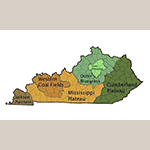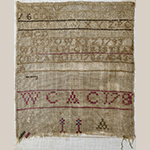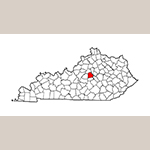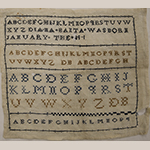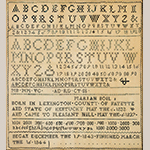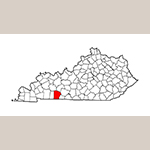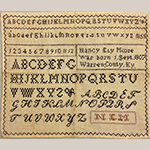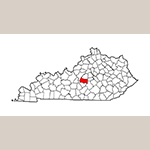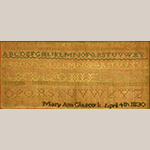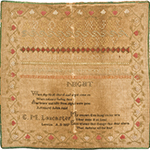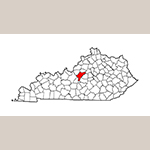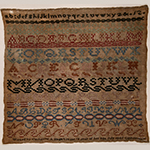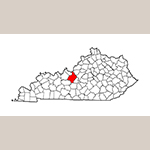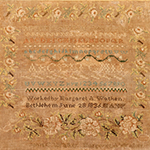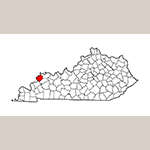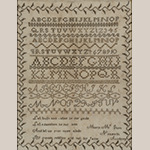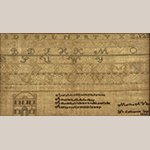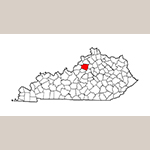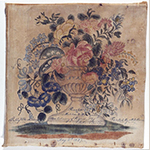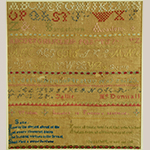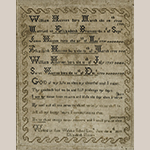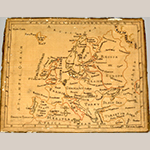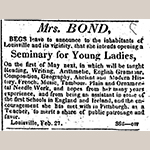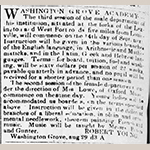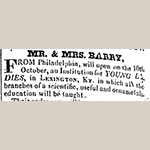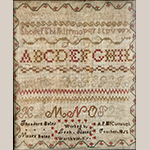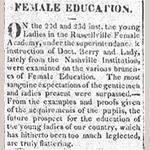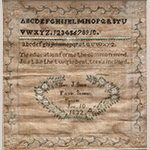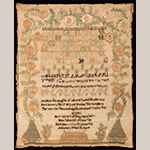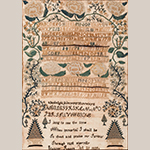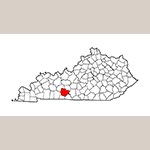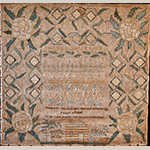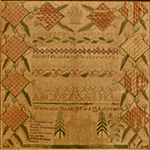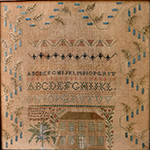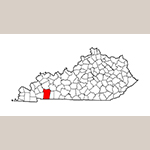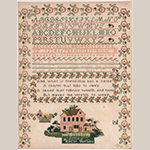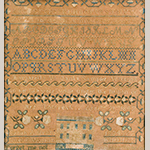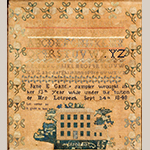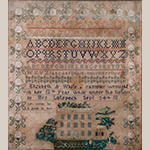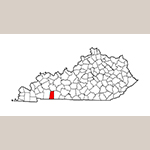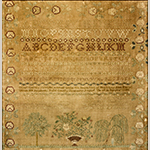|
|
Anglo-American settlement of Kentucky began in the 1770s and it was divided from Virginia and granted statehood in 1792, by which time a sampler tradition in New England, the Mid-Atlantic, and coastal regions of the South had been established for over a century and schools teaching needlework to young women were already well established.[1] Did young women and girls in early Kentucky have opportunities to go to school and make samplers like their contemporaries elsewhere in America? If so, were Kentucky’s female schools impacted by early nineteenth-century reforms in women’s education that elsewhere in America that had begun to eliminate sampler making from curricula in favor of chemistry and other classes in the sciences? And how might Kentucky’s non-Protestant female schools have influenced its sampler tradition? Without any published scholarship on Kentucky’s samplers, this study addresses those questions by beginning to contextualizing Kentucky samplers within the American South and elsewhere in America.
Samplers from New England and the Mid-Atlantic have been substantially written about since at least the early twentieth century. A sampler survey by the Colonial Dames resulted in the 1921 book American Samplers by Ethel Stanwood Bolton and Eva Johnston Coe.[2] Of the 2,500 samplers recorded in the survey, only four were identified as being made in Kentucky.[3] Seventy years after publication of American Samplers, in 1993, Betty Ring undertook a superb examination of American samplers for her two-volume Girlhood Embroidery.[4] While a significant contribution to the study of American needlework, Girlhood Embroidery does not include a single example stitched in Kentucky.
Over the past few decades a number of scholars have researched and published important scholarship on samplers made in the American South, especially the coastal states. Among them are Kim Ivey, who curated a 1997 Colonial Williamsburg exhibit on Virginia samplers and wrote the accompanying catalog, In the Neatest Manner: The Making of the Virginia Sampler Tradition.[5] Four years later, an exhibit on South Carolina samplers was produced at the Charleston Museum with a catalog, This Have I Done: Samplers and Embroideries from Charleston and the Lowcountry, written by Jan Hiester, Kathy Staples, Rachel Giesy, and Lynn Tinley.[6] The Tennessee Sampler Survey, founded in 2004 by Jennifer Core and Janet Hasson, is a living digital database that to date has identified about 250 samplers made in the Volunteer State.[7] And Gloria Seaman Allen, in addition to writing scholarly articles about Maryland, Virginia, and District of Columbia samplers, published A Maryland Sampling: Girlhood Embroidery 1738–1860 in 2007 and Columbia’s Daughters: Girlhood Embroidery from the District of Columbia in 2012.[8]
Until now Kentucky samplers have not received the scholarly attention or comprehensive surveys enjoyed by those made elsewhere in South.[9] My research, and this article, grew from a project to create a database of early Kentucky newspaper advertisements placed by teachers who taught needlework. After identifying teachers and schools, the logical next step was to identify extant Kentucky samplers. While samplers from Kentucky are not common, collectively 120 examples were found made before the American Civil War (see Appendix A). My initial efforts to create a database of newspaper notices for teachers in Kentucky revealed the existence of approximately ninety-one teachers and schools that advertised instruction in needlework before 1860 (see Appendix B).
Shortly after I had begun my investigations of Kentucky’s needlework teachers, female schools, and extant samplers, the Antique Kentucky Samplers (AKS) database was launched to document and catalog extant Kentucky samplers and contextualize them within a historical and cultural framework. My work encouraged AKS to invite me to become the project’s Scholarly Contributor. Through this ongoing project, we continue to document Kentucky samplers made from the eighteenth-century through to the Civil War.
My goal for this article, and my contributions to the Antique Kentucky Samplers project, is to provide a foundation to further our knowledge of samplers and female education in early Kentucky, encouraging deeper study of Kentucky samplers within the context of the South and elsewhere in America. I also hope that publishing my research will inspire families and collectors to share their needlework samplers stitched by young women in the Bluegrass State with the Antique Kentucky Samplers database.
— ♦♦◊♦♦ —
Overview
When and where were Kentucky samplers created? The extant samplers range in date from 1791 to 1876 and were made in thirty-nine of Kentucky’s 120 counties. The majority of the samplers were made in the Bluegrass area of Kentucky which includes the more populous cities of Lexington, Louisville, and Frankfort (Figure 1). Seventeen individual schools or teachers are responsible for nearly one-third (thirty) of the identified samplers. Individually, the samplers disclose personal and family information about the lives of their makers; collectively, they reveal the availability of female education for some Kentuckians during the last decades of the eighteenth century and through the nineteenth century.
The earliest sampler made in the region of what would become Kentucky was worked in 1793, a year after statehood, by Annie Christian Bullitt (Figure 2). On it she included the initials of her grandfather, William Christian, and the date of his death, 9 April 1786, when he was killed in a skirmish with Native Americans.
As the Anglo-American population in Kentucky grew and the displacement of Native Americans made the region attractive for even greater settlement, those families who could afford to sent their daughters to private schools. Often these were operated by women or by a partnership of husband and wife in their homes or a space in another building.
Jane Coomes is acknowledged as Kentucky’s first schoolteacher. She migrated with her husband William from Maryland to Fort Harrod, Kentucky in 1775. The residents of the fort encouraged her to open a school to educate the children living in the fort. She taught her students, which included her own children, to read and write. Needlework, however, was not seem to have been part of her curriculum.[10]
As highlighted by the teacher advertisements listed in Appendix B, opportunities for female education in Kentucky grew substantially during the nineteenth century. These institutions ranged in size from small schools operating from a single house to larger academies accommodating up to three hundred students.[11] All of these schools were privately run until 1829, when Kentucky’s first public school opened in Louisville.[12] Although available to any resident under the age of sixteen, attendance to the first public school in Louisville was not free: “The tuition consisted of $1.00 per quarter in the primary grades and $1.50 in other departments.”[13] In 1851 the first free public schools opened in the commonwealth.[14] Prior to public schools, the only options for female needlework education were home schooling, a private school such as the one operated by Jane Coomes, or a church-affiliated school. Early on, two religious institutions played an instrumental role in providing education for young women: Shakers and Catholics.
Kentucky’s Early Religious Schools for Females
Shakers
The first group from outside mainstream Protestantism to come enmasse to Kentucky were the Shakers. Pleasant Hill, in Mercer County, is the site of a Shaker community that was active from 1805 to 1910 (Figure 3). Shaker communities had already been established in New York and New England. The New York group sent out three missionaries to Kentucky. They joined the pioneers then pouring into the western lands by way of the Cumberland Gap and the Ohio River. In December 1806, forty-four Shaker converts of legal age signed a covenant agreeing to mutual support and the common ownership of property. They began living together on the 140-acre farm of Elisha Thomas.[15]
A handful of extant samplers were made by young women at Pleasant Hill and their designs reflect the Shaker’s guiding principles of simplicity, utility, and honesty. Using only alphabets and numbers, they did not include pictoral representations of houses, trees, or flowers, or decorative borders. The earliest known Pleasant Hill sampler, in the Shaker Village of Pleasant Hill collection, was stitched by Diana Banta who was born 19 January 1795 and came to Kentucky with her family in 1807 (Figure 4). She officially joined the Shaker order in 1814.[16] On 11 November 1828 Banta died at Pleasant Hill and was buried in the Shaker cemetery there, as was her mother, Dinah Dorland Banta, and sisters, Rachel and Peggy.[17] Diana Banta’s father, Samuel Banta, left the Shaker order in 1816 and was buried about eleven miles southwest of Pleasant Hill in Harrodsburg’s Dutch Reformed Church Cemetery (also known as the Mud Meeting House Cemetery).[18] The sampler stitched by Diana Banta is in three colors, navy, tan, and light-blue. It contains only alphabets and her date of birth. She did not include any numbers.
About fifteen years after Diana Banta’s death, two girls at Pleasant Hill, Mariah Boil and Paulina Bryant, stitched nearly identical samplers (Figures 5 and 6). In an unusual feature for any sampler, they included the dates when they began stitching and when they completed their samplers. Mariah Boil was born 6 May 1832 and on her fifth birthday came to Pleasant Hill. She stitched that she was born in Lexington and worked on her sampler over three months, from 19 December 1843 to 16 March 1844 (Figure 5). She stitched alphabets and numbers in different sizes, a skill necessary for marking the many linens used in the village. The sampler, in the collection of the Metropolitan Museum of Art, has dark blue silk thread on a linen ground. Boil spent most of her life at Pleasant Hill and died in 1863.[19]
Paulina Bryant was born 10 February 1808 and came to Pleasant Hill in 1810, twenty months before her mother died.[20] She began her sampler (Fig. 6) on 29 April 1844, and finished it about three months later, on 22 July 1844. As Mariah Boil used one stitch and one color, so did Paulina Bryant. She spent the remainder of her life at Pleasant Hill, eventually becoming an Eldress of the community, and died in 1886.[21]
In addition to Pleasant Hill, Shakers established a second community in Kentucky that they named South Union, located in Logan County (Figure 7). This society was begun in 1807 and reached a peak membership of 349 in 1827.[22] A South Union woman named Nancy Ely Moore made a sampler there in 1859, now in the Western Reserve Historical Society collection (Figure 8). Moore was born 1 September 1807 to Jessie Williams Moore and his wife Lucy Moore. They brought Nancy to South Union when she was four years old. Like Paulina Bryant, Nancy Moore also became as Eldress and served the South Union community her entire life. She died 5 December 1889.[23]
Catholics
Another religious group in early Kentucky that provided educational opportunities for females were Catholics. After the Revolutionary War a group of Catholic settlers migrated to the commonwealth from Maryland in search of fertile, inexpensive land. In addition, Catholics in Maryland were increasingly being persecuted for their faith. Upon their arrival in Kentucky, Catholic settlers and clergy quickly established churches and schools.[24]
In Hardin’s Creek, Marion County, Mary Rhodes was concerned that her brother’s children were not getting an education on the frontier (Figure 9). She started teaching them in her brother’s home and soon was joined by Ann Havern and Christina Stuart. They were all single Catholic women who wanted to become a religious order. They asked Charles Nerincks, a Roman Catholic missionary priest who emigrated from Belgium to work in Kentucky, to help them. In 1812 they took the name Friends of Mary at the Foot of the Cross and later shortened it to Sisters of Loretto. They organized a school in a tiny cabin in 1812, the first Catholic school in the American West.[25] The sisters outgrew the small cabin and built larger school buildings in 1834 and 1886.
To date, no Sisters of Loretto samplers from this early period have been found. The earliest known to exist was completed in 1830 by Mary Ann Glascock (Figure 10). She was born on 3 January 1816 to William Glascock and his wife Francis Dailey Glascock. Mary Ann Glascock married Thomas Johnson McGinnis on 26 October 1836 and she died on 18 June 1898. Her sampler was mounted into a tray which may have been used for religious services in the Catholic Church.[26]
Ellen Miles Lancaster’s sampler was also stitched at the Sisters of Loretto school and has alphabets with decorative bands between them and a border (Figure 11). On the bottom she included “E. M. Lancaster” and “Loretto AD 1837.” Ellen Lancaster was born 11 September 1824 in Marion County, Kentucky to John Lancaster and his wife Mary Rose Hayden Lancaster. Both of Ellen’s parents’ families were among a group of Catholics who migrated from Maryland in the late eighteenth century.[27] Ellen Lancaster married Robert Abell Spaulding, a lawyer, on 28 September 1847, and she died on 13 September 1883.[28]
In 1818 six sisters from Loretto moved to Nelson County (Figure 12) and started another school, called Gethsemani.[29] Catherine A. Hagan made a sampler at Gethsemani in 1845 (Figure 13). The sampler, part of the Kentucky Historical Society collection, has several styles of alphabets and decorative bands between them. She was born in 1832 to Thomas Hagan and his wife Ann Cissell Hagan. Catherine Hagan did not marry and died in 1901.[30]
Twelve years after Gethsemani was founded, in 1830, the Sisters of Loretto opened Bethlehem Academy in Elizabethtown, Hardin County (Figure 14). Margaret A. Wathen made her sampler there in 1836 (Figure 15). In addition to several alphabets and the numbers, she included an elaborate floral border. She was born 23 April 1820 to Gabriel Wathen and his wife Seany Asenath Little Wathen. Margaret Wathen married John Caldwell Walker on 23 January 1838. After her marriage she stitched below the floral border: “John C. Walker. Margaret A Walker.”[31]
In 1808, the Catholic Diocese of Bardstown was established in Nelson County, Kentucky (see Fig. 12). As in the communities previously discussed, the Catholic families who had migrated from Maryland after the Revolutionary War to Bardstown required religious education for their children. In response to this need, Father John Baptist David called for young women willing to devote their lives to the service of the Church. A group of six women responded, among them was Catherine Spalding. These six women became the Sisters of Charity of Nazareth in Bardstown, founded in 1812.[32]
Catherine Spalding was born in Charles County, Maryland, on 23 December 1793. At the age of three years old, Spalding and her family moved to Kentucky. Her mother died shortly after they arrived. Her father Edward Spalding remarried but then abandoned the family. Catherine Spalding’s uncle, Thomas Elder, and his wife brought her back to Maryland. He then accompanied Spalding to Kentucky in January 1813 in response to Father John Baptist David’s invitation to be part of a new religious community.[33]
In 1814 the Sisters of Charity opened a one-room school at St. Thomas Farm, near Bardstown. In 1822 the sisters moved to Nazareth (about three miles north of Bardstown) and built a new school. Within a decade, the school known as the Nazareth Academy could accommodate one hundred boarders. Each time the Sisters of Charity opened an academy in Kentucky they also offered “free” instruction to nearby girls who could not afford tuition.[34]
Mother Catherine Spalding was responsible for the opening of more schools in Kentucky for the Sisters of Charity: Bethlehem Academy (Bardstown, 1819); St. Vincent’s Academy (Morganfield, Union County, 1820 [Figure 16]); St. Catherine’s Academy (Scott County, 1823, and moved to Lexington in 1833); and Presentation Academy (Louisville, 1831). All of these schools except St. Vincent’s Academy were located in the Bluegrass region of Kentucky (Fig. 1).
Mary McGuire made her sampler at the Nazareth Academy (Figure 17). She only used one color thread and included several alphabets and numbers. The sampler is in the Speed Art Museum’s collection. McGuire was born circa 1825; nothing else is known about her life or family.[35]
In general, the samplers from Kentucky’s Catholic schools contain alphabets with decorative bands between them and a border; some also contain inscriptions. A sampler in the MESDA collection stitched by Martha Ann Viley (Figure 18), completed at St. Catherine’s Academy, is an anomaly as it includes a small house. She was born in 1819 to Willa Janes Viley and his wife Lydia Smith Viley in Scott County.[36] Her father was a farmer but also very successful in breeding and training race-horses.[37]
Protestants
With Catholic schools seemingly well established in Kentucky, it was determined that “a good Protestant school was much needed.”[38] Although tuition at Catholic schools was often less expensive than Protestant schools, some Protestant parents of young women educated at Catholic schools lamented that their daughters returned to them “thoroughly imbued with Romanism.”[39] In response, Science Hill Female Academy was established by Julia Ann Hieronymus Tevis on 25 March 1825 in Shelbyville, Shelby County (Figure 19).
Julia Ann Hieronymus was born 5 December 1799 in Clark County, Kentucky, to Pendleton Hieronymus and his wife Mary Bush Hieronymus. Her grandparents on both sides had migrated to Kentucky from Virginia. At the age of four she was sent off to the local country school to learn to read and write. Her parents were not pleased with the educational opportunities for their children in Clark County and when Julia Ann Hieronymous was seven the family relocated to the town of Paris in Northern Virginia. After two years the family moved to Winchester, Virginia and stayed there three years before moving in 1813 to Washington, DC. Julia Ann Hieronymus attended three schools during the next five years.[40]
A reversal in her family’s finances required Julia Ann Hieronymus to take up school teaching. She started in Abington, Virginia. In March 1824 she married Rev. John Tevis, an itinerant Methodist preacher. In an unusual situation for the time, it was decided that she would continue to teach—a profession for which her husband wrote she was “unusually well qualified.”[41] Within a year the couple moved to Kentucky where they opened Science Hill Female Academy in Shelbyville. With that move, Julia Ann Hieronymus Tevis came full circle: born in Kentucky, educated in Virginia and the District of Columbia, and returning to Kentucky to establish one of the commonwealth’s most important early schools for girls.
The curriculum at Science Hill included math and science, since Julia Ann Hieronymus Tevis felt these subjects were important for females. Needlework was also taught, but she eschewed “the tall brick house, the angular figures and stunted trees sometimes decorating these species of needlework with the twenty different stitches taught in the olden times.”[42] Her husband helped with the teaching, but she was the principal for over fifty years until the school was sold in 1879. During her tenure at Science Hill, she also had six children.[43] Julia Ann Hieronymus Tevis was a noteworthy early pioneer for women’s education in Kentucky, and a successful businesswoman.
While research is ongoing to identify samplers made at Science Hill Female Academy, a presentation painting in the Colonial Williamsburg collection for a student named Matilda W. Montgomery was painted by an artist named M. D. Rouse and includes the name “Julia A. Tevis” (Figure 20).[44]
Seven years after Science Hill opened, in 1832, Rev. Nathan L. Rice established the Bardstown Academy, a Protestant female academy intended to compete with the region’s numerous Catholic schools. In 1848 the Bardstown Academy was taken over by Rev. Jouett Vernon Cosby, who ran the school until his death in 1877 (with the exception of four years during the Civil War during which he was absent). His widow, Margaret Powell Cosby, continued operating the school until 1881.[45] A newspaper ad placed by Cosby in 1851 stated that “Needle-Work was free of charge.”[46] One student at the school, Sallie McDonnall, included the words “Bardstown Academy” on her sampler (Figure 21). She was born 6 February 1835 and married 4 May 1853 to John Bemiss Merrifield.[47]
Kentucky Needlework Teachers
There were teachers advertising needlework instruction at small private schools in Kentucky at least a decade before the first Shaker or Catholic female academies were established. The first known advertisement of a needlework teacher in a Kentucky newspaper was placed by Mrs. Ann Walsh, who in 1795 wrote that she: “Begs leave to inform her friends and the public, That she continues to instruct young ladies in NEEDLEWORK.”[48] By 1806 she posted a notice that she had added reading and writing to her curriculum.[49] A year later she placed the following:
ANN WALSH BEGS leave to inform her friends and the public, that she opens her SCHOOL For the Instruction of YOUNG LADIES, in Needle-work, Drawing, Reading, &c. the first week in March. She presumes the work done in her School, together with her low prices, will continue unto her, a portion of their patronage. She will also take in Drawing for ladies out of School.[50]
By 1810 she had added English grammar and arithmetic to her curriculum.[51]
One sampler survives from Ann Walsh’s school, stitched by Elizabeth Huston in 1807 (Figure 22). Now in the collection of the Speed Art Museum, this sampler is a very rare family record. It includes the name of Elizabeth Huston’s father and the date of his birth, the name of her mother, the date of their marriage, and the names and birth dates of her siblings as well as her own. On the bottom she stitched, “Worked in Ann Walsh’s school Lexington June the 4th 1807” and then her name again.
Elizabeth Huston was born 13 March 1795 to William Huston and his wife Elizabeth Bratton Huston in Lexington, Kentucky. Her father was a saddler.[52] She married William Taylor on 20 September 1814 and died 28 December 1817, nine days after the birth of their daughter, also named Elizabeth.[53]
In addition to the family information, Elizabeth Huston included a verse on her sampler. The only stitch used is the basic cross stitch and she did not include a house or other ornamental features except for a border. Due to the relative simplicity found in Elizabeth Huston’s technique and her sampler’s design, Ann Walsh’s instruction in needlework may have only included basic sewing, marking linens with initials, and the rudiments of stitching a sampler.
In 1805 a Mrs. Beck advertisted that she was instructing the young ladies of Lexington in “Reading, Spelling, Writing, & Arithmetic, Grammar, Composition and Geography, Music, Dancing, Drawing and Embroidery… .”[54] This was an advanced curriculum for females at this time, and Mrs. Beck noted that she “respected the female mind and was diligent in expanding its horizons.”[55] She charged $250 per annum.
Mrs. Beck’s instruction in geography may have involved requiring her students to create maps using embroidery.[56] The map sampler illustrated in Figure 23 was embroidered by Elizabeth Minor Carr in 1806. It is not known which school she attended. Map samplers are rare, and while most depict the United States this example is a map of Europe. Elizabeth Minor Carr was born 5 April 1791, to Walter Chiles Carr and his wife Elizabeth Chiles Carr. She married Thomas Fiveash Riddick on 8 August 1812. Sometime around 1821 the couple moved to Missouri, and Elizabeth Carr Riddick died there 2 January 1866.[57] The sampler is now in the collection of the Missouri Historical Society.
The Lexington schoolteacher Mrs. Beck was a French-born artist named Mary Menessier Beck. She may have been educated or studied art in England because it was there in 1786 that she married George Beck, also an artist.[58] The couple both exhibited their work with the Society of Artists of Great Britain before emigrating to Baltimore, Maryland by 1793.[59] Mary Beck taught in Philadelphia before moving to Lexington, Kentucky to teach. George Beck painted and also taught at his wife’s Lexington academy. He died 14 December 1812 and she continued teaching in Lexington.[60] In 1829 she went to Cincinnati to teach in Dr. Locke’s Cincinnati Female Academy. Mary Menessier Beck died there on 12 October 1833 during a cholera outbreak.
Teachers continued to arrive in Kentucky in the early nineteenth century, coming from all points of the United States and abroad. For instance, a Mrs. Bond opened a Louisville seminary for young ladies in 1822. She advertised that she had taught in England, Ireland, and Pittsburgh before arriving in Kentucky (Figure 24).
Louisville’s Washington Grove Academy in 1840 had both young women and young men students, with a Mrs. Lowe from Oxford, Massachusetts heading the “female department” and Robert Young presumably teaching the boys (Figure 25). A Mr. and Mrs. Barry came from Philadelphia to open a school in Lexington, Kentucky in 1831. To attract students from adjacent states, the Barrys advertised their school in an Indiana newspaper (Figure 26).
The teachers identified in Appendix B either advertised in a newspaper or are identified on a sampler. Leah Bates included the name of her teacher, A. P. McCullough, on her sampler (Figure 27). A note kept with Leah’s sampler indicated that A. P. McCullough was a teacher at the Loretto Monastery School in Breckinridge County, located on the Ohio River southwest of Louisville; however, Leah stitched “Worthville, Kentucky” on her sampler. Worthville is situated a hundred miles up the Ohio River from Beckinridge County, on the other side of Louisville. Either Leah Bates traveled quite a distance to attend the Loretto Monastery School, or her teacher A. P. McCullough taught in a number of locations in the region. Both of those situations are equally possible. Leah Bates was born 8 March 1843 to Theodore Wythe Bates and his wife Mary Ann Gullion Bates. Leah Bates married on 28 May 1868 to Warren E. Nash and she died in 1905.[61]
Dr. Daniel Berry and his wife were from Salem, Massachusetts and moved to Tennessee to start the Nashville Female Academy in 1817.[62] They left Nashville in July 1819 to open the Russellville Female Academy in Russellville, Kentucky. In January 1820 they advertised that they had held public examinations at the academy, a common practice for schools to show off the talents of their pupils and attract new students (Figure 28).[63] Chloe Ann R. Bysor was a student at the Academy in 1835 and made a sampler that included its name (not illustrated here but available online in the National Society of the Colonial Dames’s Survey of Samplers [Alphabet Sampler #122]).[64]
Mary J. Sharp included the name “Franklin Seminary / Kentucky” in a cartouche on her sampler completed in 1832 (Figure 29). This academy probably did not last long as no more information has been found about it. Mary Jane Sharp was born 23 May 1825 to James Sharp and and his wife Elizabeth Ruddle Sharp. On 25 November 1852 Charles William Breeden married Mary Jane Sharp. She died 3 October 1900.[65]
Kentucky Sampler Groups from Unidentified Schools
When multiple samplers exhibit similar designs or decorative elements they can often indicate a grouping made under the same teacher or at a specific school. To date, only three groups of Kentucky samplers related to unidentified teachers or schools have been identified.
Group 1
Louisiana Shrader in 1825 and Eleanor Reeve in 1828 stitched samplers that have two large urns containing a cone-shaped stack of fruit (Figures 30 and 31). Louisiana Shrader lived in Louisville, so her sampler—and perhaps Eleanor Reeve’s—may have been made in that city. Louisiana Shrader’s sampler is now in the Colonial Williamburg collection. She was born 17 January 1812 to Colonel John Shrader and his wife Rachel Ross Shrader. John Shrader was a farmer and served in the War of 1812. Louisiana Shrader married 15 July 1828 to Cullen Melone and she died 27 April 1843.[66]
Eleanor Reeve included eight sets of alphabets and numbers with decorative bands between them. She was born May 1819 in Indiana but based on the similarities of her sampler with the designs found on Louisana Shrader’s, Eleanor Reeve may been sent to Louisville for her education. She died in Evansville, Indiana on 24 July 1903.[67]
Group 2
In 1843 three samplers were made in the Smith’s Grove community in Warren County, Kentucky (Figure 32). The samplers all have elaborate borders and a central area with alphabets and decorative bands between them and depict a house of some type. (Figures 33, 34, and 35).
The house on Catherine Bishop Allen’s sampler is a log cabin (Fig. 33). According to her family’s tradition, while attending school in Smith’s Grove she saw a log cabin being transported to the nearby town of Bowling Green for an 1840 political rally in support of William Henry Harrison, the “log cabin” candidate for president.[68] Catherine Bishop Allen included other Harrison campaign iconography and slogans on her sampler: the the phrase “To log Cabin frugality, We owe our independence,” and to one side of the cabin the lettering “W. H. Harrison” and on the other side an image of a barrel of cider under the lettering “H Cider.”
All of the three samplers in this group include the names of the plantations where presumably the girls lived: “Pleasant Retirement” for Catherine Allen and “Point Retirement” on the samplers by sisters Nancy P. Ford and Mary Charlotte Ford (Fig. 34 and Fig. 35, respectively). The three samplers in this group show advanced techniques that include cross, eyelet, four-sided, and queen stitches. They were all completed in the early 1840s, and Mary Charlotte Ford included the exact date of 18 February 1843 on hers (Fig. 35).
Catherine Bishop Allen was a daughter of William Allen and his wife Mary Carter White Allen. Born 1 March 1829, Catherine Bishop Allen married Harrison Perry Barner on 18 October 1859, and she died in Bowling Green on 5 March 1912.[69] Nancy Patterson Ford and her sister Mary Charlotte Ford were daughters of William Ford and his wife Nancy Ann Embry Ford. Older sister Nancy Patterson Ford was born in December 1829, married Henry Tandy Arnold on 20 December 1855, and died in Nashville, Tennessee on 19 February 1901.[70] Mary Charlotte Ford was born 7 January 1832, married Woodford Mason Dunn on 11 September 1849, and died in Sumner County, Tennessee on 26 August 1915.[71]
Group 3
A teacher named Nancy Western Lotspeich is associated with the third grouping, but how she is connected with all of the associated samplers is unknown. She married David Lotspeich in 1819 in Hopkinsville, Christian County, Kentucky (Figure 36). Her husband died in 1832 and she apparently took up teaching to support her six children, including daughter Mary Magdalene Lotspeich, who was born very close to the time of her father’s death.[72] On her circa 1843 sampler, Mary Magdalene Lotspeich stitched that she was “under the tuition of her mother” (Figure 37). Christian County is in the southwestern part of Kentucky, a region where few samplers are known to survive. The town of Hopkinsville was established in 1804. By the 1830s it was well established and Nancy Lotspeich would probably not had much trouble finding students to learn advanced stitches. As a child she lived near Frankfort, where she may have learned her embroidery skills.[73]
Approximately four years after Mary Magdalene Lotspeich completed her sampler, a girl named Margaretta Waller Gant made a similar sampler and included the words under the “tuition of Mrs. Lotspeich” (Figure 38). Margaretta Waller Gant’s younger sister, Virginia “Jane Ellen” Gant, and a girl named Elizabeth Ann White also made samplers under the “tuition of Mrs. Lotspeich” (Figures 39 and 40, respectively). Jane Ellen Gant and Elizabeth Ann White both finished their nearly identical samplers on 24 September 1848.
Margaretta Waller Gant and Jane Ellen Gant were the daughters of Archibald Gant and his wife Rebecca Kinkead Gant. Their father was the first hatter in Hopkinsville and is said to have “made a fortune in the hat business.”[74] Elizabeth Ann White was born 27 November 1836 to Thomas Edward Calvin White and Martha Jane Valentine White, married Alexander Campbell Overshiner on 6 June 1865, and died in Hopkinsville on 11 August 1918.[75]
All four of the samplers share a common design with a building at the center bottom. Mary stitched “Mount Vernon”; Margaretta “Home”; and Jane Ellen and Elizabeth both stitched “Arcadia.”[76] The three girls used the same border and Margaretta Gant included four flower motifs from that border. Her sampler includes the names of two friends, Sarah A. Means and Juliet E. Woshan, along with the statement “Forget me not” and “Remember me.”
In 1862 Nancy Lotspeich moved to Tangipahoa, Louisiana where by 1867 she had established the Amite Seminary. Her daughter accompanied her to Louisiana and on 28 August 1876 Mary Magdalene Lotspeich married Jahleel Woodbridge in Tangipahoa. Both she and her husband taught at Amite Seminary. Nancy Lotspeich died in Tangipahoa in 1889 and Mary Magdalene Lotspeich Woodbridge lived there until her death in 1904.[77]
A fifth sampler in this group shares the border of those completed under the instruction of Nancy Lotspeich in Hopkinsville but was stitched not in Christian County but in Todd County (Figure 41). Mary “Susan” Garth made her sampler under the tutelage of Mrs. Lucy Ann Day (Figure 42). Susan Garth completed working her sampler in 1840, a few years before Mary Magdalene Lotspeich’s.
We can only speculate how Susan Garth or her teacher Lucy Ann Day may have met or had access to the same border pattern used by Nancy Lotspeich’s pupils. Susan Garth was born 8 October 1833 to William Garth and his wife Elizabeth Baker Saffrans Garth in Todd County, where she married John H. Bell in 1849. The couple moved to Christian County by 1850 and she died in Hopkinsville on 14 November 1903.[78] Susan Garth’s teacher, Lucy Ann Lipsomb Day moved to Todd County with her husband Rev. Charles Morris Day and together they opened the Union Hill Academy. She was born on 13 January 1813 in Virginia and married Rev. Day in Spotsylvania County, Virginia on 13 January 1831.[79] No further information about Union Hill Academy is known and there has not been any connection found between Lucy Day and Nancy Lotspeich. Lucy Day died sometime before December 1851, when records indicate Rev. Day had remarried, to Mary Chilton Perkins.[80]
Conclusion
Noted female educational reformer Catherine Beecher, sister of author and abolitionist Harriet Beecher Stowe, advocated to improve educational opportunities for females in nineteenth century America, especially in the newly settled lands in the west. In 1832 she left the institution she had established in Connecticut, the Hartford Female Academy, and moved to Cincinnati, Ohio where she opened another school and continued to campaign for more female academies and teachers. After travelling through Kentucky and observing the abundance of female Catholic schools, she strongly encouraged Protestant clergy to open their own academies in the commonwealth, providing families with non-Catholic options to educate their daughters.[81]
Teaching needlework and other ornamental instruction in female academies declined as the nineteenth century progressed and schools began to introduce subjects such as chemistry, astronomy, and botany. As early as 1816 James Blythe at the Lexington Seminary offered chemistry classes to girls but excluded needlework instruction.[82] By the 1830s, many schools in northern states were no longer providing needlework instruction; however, the sampler tradition was prolonged a bit longer in the South and and on the western frontier where teachers continued to offer needlework as part of their curriculum.[83]
Catholic schools retained needlework as part of their instruction the longest, in both the South and the North. In 1839 the female academy run by the Sisters of Charity of Nazareth in Bardstown, Kentucky offered both chemistry and needlework.[84] Over twenty years later the curriculum at the Female Academy of St. Catherine of Sienna near Springfield, Kentucky, included instruction in “Sewing and Marking.”[85]
The identification of over 120 extant Kentucky samplers along with documentation of at least 94 teachers and educational institutions providing needlework instruction demonstrates that many young girls in Kentucky did indeed have access to needlework instruction. Sampler making was an important facet of their academic curriculum. With that foundation established, my continued research—and that of others—can continue to contextualize Kentucky samplers within the American South and elsewhere in America. The schools operated by Shakers and Catholics are particularly ripe for deeper study. And, finally, it is hoped that publication of this study will result in the identification of even more samplers stitched by early Kentucky’s talented female students.
Sheryl De Jong has worked with the needlework collection at the National Museum of American History as a volunteer since 1998. She writes and lectures on American samplers and embroidery. She can be contacted at [email protected].
APPENDIX A: Identified Kentucky Samplers
|
Date |
Maker |
Medium |
Collection |
|---|---|---|---|
|
1791 |
McDowell, Isabella |
silk on linen |
private collection |
|
1793 |
Bullitt, Annie Christian |
silk on linen |
private collection |
|
1798 |
Trabue, Ann (Nancy) |
silk on linen |
DAR, 2026 |
|
1800 |
Gibson, Mary |
not recorded |
private collection; American Samplers (1921), p. 162 |
|
1806 |
Carr, Eliza Minor |
silk on linen |
State Historical Society of Missouri |
|
1807 |
Huston, Elizabeth |
silk on linen |
Speed Museum of Art, 2011.9.19 |
|
1808 |
Ward, Matilda |
not recorded |
private collection; American Samplers (1921), p. 236 |
|
1810 |
Jones, Martha Melvina Milledge |
not recorded |
private collection; American Samplers (1921), p. 182 |
|
1811 |
Preston, Ann |
silk on linen |
private collection |
|
1812 |
Protsman, Elizabeth |
silk on linen |
private collection |
|
1813 |
Logan, Mary Ann |
silk on linen |
Filson Historical Society |
|
1813 |
Short, Jane Ann |
silk on linen |
private collection |
|
1814 |
Hope, Mary A. J. |
silk on linen |
private collection |
|
1816 |
Ellis, Lucinda |
silk on linen |
private collection |
|
1817 |
Brent, Sarah Bell |
silk on linen |
KY Historical Society, 2004.64 |
|
1818 |
Carter, Mary Ann |
not recorded |
private collection; American Samplers (1921), p. 136 |
|
1819 |
Fitch, Louisa |
cotton on linen |
KY Historical Society, 1990.18.4 |
|
1819 |
Gray, Eliza Paul |
silk on linen |
private collection |
|
1821 |
Lafon, Mary Virginia |
cotton on linen |
KY Historical Society, 1962.152 |
|
1822 |
White, Mary M[arder] |
wool on linen |
Winterthur |
|
1823 |
Covington, Caroline |
silk on linen |
private collection |
|
1824 |
Shekels, Sarah |
silk on linen |
private collection |
|
1825 |
Frank, Teresa |
not recorded |
private collection |
|
1825 |
Keenan, Elizabeth |
silk on linen |
private collection |
|
1825 |
Shrader, Louisiana |
silk on linen |
Colonial Williamsburg Foundation Acc. No. 2002-21. |
|
1825 |
Thornton, Mary Rhodes |
linen ground |
private collection |
|
1825 |
Younger, Amacette |
silk on linen |
private collection |
|
1826 |
White, Mary Ann |
silk on linen |
Filson Historical Society |
|
1827 |
Kendall, Elizabeth |
linen on linen |
private collection |
|
1827 |
Turner, Sarah Thomas |
cotton, silk on linen |
KY Historical Society, 1950.37 |
|
1828 |
Reeve, Eleanor |
silk on linen |
private collection |
|
1829 |
Parr, Caroline |
silk on linen |
Leslie Durst |
|
1829 |
Simpson, Agnes |
linen on linen |
private collection |
|
1830 |
Glascock, Mary Ann |
silk on linen |
private collection |
|
1831 |
Darnaby, Francis Mary |
silk on linen |
private collection |
|
1831 |
Morris, Louisa Fontain |
silk on linen |
Missouri Historical Society |
|
1831 |
Rogers, Jane |
silk on linen |
private collection |
|
1831 |
Spears, Elizabeth |
silk on linen |
private collection |
|
1832 |
Pate, Mary Ann |
silk on linen |
private collection |
|
1832 |
Pearson, Elizabeth |
silk on linen |
private collection |
|
1832 |
Sharp, Mary J |
silk on linen |
private collection |
|
1833 |
Viley, Martha Ann |
silk on linen |
MESDA, Acc, 5800.3 |
|
1834 |
Blincoe, Mary A E |
silk on linen |
Colonial Williamsburg, Acc. 2009-118 |
|
1834 |
Hutchinson, Laura |
silk on linen |
private collection |
|
1835 |
[?], Deborah |
not recorded |
private collection |
|
1835 |
Bysor, Chloe Ann R. |
silk on linen |
private collection |
|
1835 |
Chapeze, Mary |
silk on linen |
private collection |
|
1835 |
Cooper, Louisa |
silk on linen |
private collection |
|
1835 |
Galbraith, Mary Eleanor |
silk on linen |
private collection |
|
1835 |
Wade, Mary |
silk on linen |
private collection |
|
1836 |
Brandenburg, Susannah |
silk on linen |
private collection |
|
1836 |
Cannon, Caroline Matilda |
don’t know |
private collection |
|
1836 |
Tureman, Mary Ann |
silk on linen |
Historic Travelers Rest Plantation Museum |
|
1836 |
Wathen, Margaret A |
silk on linen |
Leslie B. Durst Collection |
|
1837 |
Guthrie, Ann A. |
silk on linen |
Filson Historical Society |
|
1837 |
Lancaster, Ellen Miles |
wool on linen |
private collection |
|
1837 |
Walker, Mary E. |
silk on linen |
private collection |
|
1838 |
Cannon, Caroline Matilda |
don’t know |
private collection |
|
1838 |
Harbison, Mary Eliza |
silk on linen |
Colonial Williamsburg Foundation, Acc. No. 2017-295 |
|
1838 |
Pollitt, Ann Ballard |
silk on linen |
private collection |
|
1839 |
Davis, Eliza |
wool on linen |
Colonial Williamsburg Foundation, Acc. No. 2015-156 |
|
1840 |
Cole, Zerelda |
silk on linen |
Jesse James Museum |
|
1840 |
Garth, Susan |
silk on linen |
Leslie B. Durst Collection |
|
1840 |
Tennis, Julia |
silk or cotton on linen |
private collection |
|
1841 |
Hanly, Ann S. |
silk on linen |
private collection |
|
1841 |
Paxton, Pamela |
silk on linen |
private collection |
|
1841 |
Sampson, Jane |
not recorded |
private collection |
|
1842 |
Ashcraft, Elizabeth |
silk on linen |
Archdiocese of Louisville |
|
1842 |
Lotspeich, Mary Magdalene |
silk on linen |
Speed Museum of Art, 2014.4 |
|
1843 |
Allen, Catherine B |
silk on linen |
private collection |
|
1843 |
Ford, Mary Charlotte |
silk on linen |
private collection |
|
1843 |
Ford, Nancy Patterson |
silk on linen |
private collection |
|
1843 |
Underwood, Mary Ann |
cotton or wool on linen |
private collection |
|
1844 |
Boil, Mariah |
silk on linen |
Metropolitan Museum of Art, , Acc. 2008.453 |
|
1844 |
Bryant, Paulina |
silk on linen |
Waiolo Corporation, Lihue, Kauai, HI |
|
1844 |
Pope, Bettie |
silk on linen |
Filson Historical Society |
|
1845 |
Byrns, Lucy J |
silk on linen |
private collection |
|
1846 |
Penny, Annie |
wool on linen |
private collection |
|
1847 |
Gant, Margaretta Waller |
silk on linen |
MESDA, 5402.2 |
|
1847 |
Miller, Mary W |
cotton on linen |
KY Historical Society, UNNUMBERED-1235 |
|
1848 |
Gant, Virgina “Jane Ellen” |
silk on linen |
MESDA, 5402.3 |
|
1848 |
Simm, Henriette |
wool on linen |
private collection |
|
1848 |
White, Elizabeth Ann |
silk on linen |
Customs House Museum & Cultural Center Collection, TN |
|
1849 |
Dudley, Harriet B. |
cotton & wool on linen |
private collection |
|
1851 |
McRoberts, Susan Elmonia |
wool on linen |
private collection |
|
1851 |
Wright, Susanna Alina |
wool on cotton |
private collection |
|
1856 |
Bates, Leah |
silk on cotton |
private collection |
|
1856 |
Milliken, Nettie |
wool |
private collection |
|
1859 |
Moore, Nancy Ely |
cotton on linen |
Western Reserve Historical Society |
|
1859 |
Smith, Malvina |
not recorded |
private collection |
|
1863 |
Cobb, Bettie |
silk on cotton |
Speed Museum of Art, 2011.9.16 |
|
1864 |
Tipton, Jessie |
silk and wool on cotton |
private collection |
|
1865 |
Ellis, Mary Ellen |
wool and cotton on linen |
private collection |
|
1865 |
Hill, Cynthia Ann |
Silk and wool on linen |
Archdiocese of Louisville |
|
1870 |
Calvert, Mary |
wool on linen |
Kentucky Museum, Western Kentucky University |
|
1873 |
Reed, Annie M. |
silk on linen |
Speed Museum of Art, 2011.9.20 |
|
1876 |
anon., Sisters of Loreto |
not recorded |
private collection |
|
1810-1815 |
Johnson, Mary |
silk on linen |
MESDA, 5829.3 |
|
1815-1830 |
Nelson, Ann |
wool on linen |
Speed Museum of Art, 2011.9.18 |
|
1820-1830 |
White, Emalina |
silk on linen |
private collection |
|
1828? |
Inman, Eunice Louisa |
silk on linen |
private collection |
|
1835-45 |
Deppen, M |
wool & silk on linen |
private collection |
|
1845-1855 |
Vail, Florence Cosby |
wool on linen |
The Bennington Museum |
|
c 1849 |
McDonnall, Sallie |
wool on linen |
private collection |
|
c. 1813 |
Pilcher, Nancy Ann |
silk on linen |
private collection |
|
c. 1820 |
Todd, Francis Ann |
silk and wool on linen |
private collection |
|
c. 1823 |
Allen, Mary Ann |
silk on linen |
private collection |
|
c. 1840 |
Barrow, Ann |
wool on linen |
private collection |
|
ca1815-25 |
Nall, Cynthia |
cotton, silk on linen |
KY Historical Society, 1988.9 |
|
unknown |
Maxcy, Susan D. |
silk on linen |
private collection |
|
unknown |
Banta, Diana |
silk on linen |
Pleasant Hill, KY, Acc. 93.9.2. |
|
unknown |
Braxdale, Malinda |
silk on linen |
Filson Historical Society |
|
unknown |
Campbell, Rebecca Brown |
cotton on linen |
private collection |
|
unknown |
Churchill, A.P. |
silk on linen |
Filson Historical Society |
|
unknown |
Gatton, Helen |
not recorded |
private collection |
|
unknown |
Gossom, Elizabeth |
silk on linen |
KY Museum, KM2016.39.1 |
|
unknown |
Hagan, Catherine A |
wool on linen |
KY Historical Society, 1989.15 |
|
unknown |
McGuire, Mary |
silk on linen |
Speed Museum of Art, 2015.7.2 |
|
unknown |
Payne, Mary C. |
cotton ground |
Pleasant Hill, KY, 75.10 |
|
unknown |
Spaulding, Elizabeth |
wool on linen |
Pleasant Hill, KY, C2004.09 |
APPENDIX B: Newspaper Notices for Teachers in Kentucky
|
Date |
Academy, City, or County |
Teacher (last name first) |
Bibliography |
|
1797 |
Scott Co. |
Goodlet, Alison |
MESDA Craftsman Database ID 13571. |
|
1802 |
Lancaster |
Elliott, Mrs. |
Lancaster Intelligencer and Journal, October 13, 1802, digital images available at Newspapers by Ancestry (https://www.newspapers.com; accessed 2 December 2020). |
|
1806 |
Lexington |
Green, Mrs. |
Palladium, June 26, 1806, digital images available at Nineteenth Century U. S. Newpapers (https://www.gale.com/c/nineteenth-century-us-newspapers: accessed 22 November 2015), MESDA Craftsman Database ID 13987; teaching with her husband. |
|
1808 |
Lexington |
Evans, Mrs. |
Kentucky Gazette, March 15, 1808, digital images available at Newspapers by Ancestry (https://www.newspapers.com; accessed 2 December 2020). |
|
1808 |
Washington |
Keets, Mrs. |
MESDA Craftsman Database ID 84269. |
|
1808 |
Washington Domestic Academy |
Ethel Stanwood Bolton and Eva Johnston Coe, American Samplers, (Boston: Massachusetts Society of the Colonial Dames of America, 1921), 236. Accessed March26, 2012, http://books.google.com/books/about/American samplers.html?id=QrHYAAAAMAAJ. |
|
|
1809 |
Middletown |
Gray, Mrs. |
MESDA Craftsman Database ID 74324. |
|
1810 |
Richmond |
Jacobs, Mrs. |
The Globe, August 1, 1810, America’s Historical Newspapers (https://www.readex.com/products/americas-historical-newspapers: accessed 18 November 2011), MESDA Craftsman Database ID 84219. |
|
1811 |
Georgetown |
De Charms, Mrs. & Miss |
MESDA Craftsman Database ID 8821. |
|
1813 |
Lexington |
Everitt, Mrs. |
MESDA Craftsman Database ID 11072. |
|
1814 |
Lexington |
Cabill, Mary |
MESDA Craftsman Database ID 5147. |
|
1814 |
Millersburg |
Porter, Susanna |
The Western Citizen, May 14, 1814, digital images available at Nineteenth Century U. S. Newpapers (https://www.gale.com/c/nineteenth-century-us-newspapers: accessed 22 November 2015). |
|
1815 |
Lexington |
De Charms, Miss |
The Western Monitor, March 24, 1815, digital images available at America’s Historical Newspapers (https://www.readex.com/products/americas-historical-newspapers: accessed 19 March 2012).taught with Miss Spencer; MESDA Craftsman Database ID 8822. |
|
1815 |
Louisville |
Elliott, Mrs. |
MESDA Craftsman Database ID 10508.. |
|
1815 |
Lexington |
Spencer, Mrs. |
The Western Monitor, March 24, 1815, digital images available at America’s Historical Newspapers (https://www.readex.com/products/americas-historical-newspapers: accessed 19 March 2012). taught with Miss DeCharms; MESDA Craftsman Database ID 37124. |
|
1816 |
Seminary for Young Ladies, Lexington |
Pyle, Mr. R. |
The Western Monitor, February 9, 1816, digital images available at Nineteenth Century U. S. Newpapers (https://www.gale.com/c/nineteenth-century-us-newspapers: accessed 18 November 2011). |
|
1817 |
Lexington Lycaeum |
Howard, Mrs. |
The Western Monitor, May 23, 1817, America’s Historical Newspapers (https://www.readex.com/products/americas-historical-newspapers: accessed 18 November 2011), MESDA Craftsman Database ID 55519, taught in Washington, DC. |
|
1817 |
Louisville |
Stillman, Mary Ann |
MESDA Craftsman Database ID 38089. |
|
1818 |
Frankfort |
Ben Alli, Miss |
Frankfork Argus, January 22, 1819, digital images available at Nineteenth Century U. S. Newpapers (https://www.gale.com/c/nineteenth-century-us-newspapers: accessed 22 November 2015), MESDA Craftsman Database ID 28155; teaching with Miss Holcomb; from Philadelphia. |
|
1818 |
Frankfort |
Holcomb, Miss |
Frankfork Argus, January 22, 1819, digital images available at Nineteenth Century U. S. Newpapers (https://www.gale.com/c/nineteenth-century-us-newspapers: accessed 22 November 2015), MESDA Craftsman Database ID 16815; teaching with Miss Ben Alli; from Philadelphia. |
|
1818 |
Maysville |
Spencer, Miss |
MESDA Craftsman Database ID 73035. |
|
1819 |
Russellville |
Berry, Doctor and Mrs. [Daniel] |
MESDA Craftsman Database ID 2529; from Massachusetts; opened the Nashville Female Academy in 1817 and left in 1819. |
|
1820 |
Lexington |
Grace, Mrs. |
Kentucky Reporter, November 6, 1820, digital images available at Nineteenth Century U. S. Newpapers (https://www.gale.com/c/nineteenth-century-us-newspapers: accessed 18 November 2011). |
|
1820 |
Louisville |
Scribner, Mrs. E. |
Louisville Public Advertiser, September 23, 1820, digital images available at Nineteenth Century U. S. Newpapers (https://www.gale.com/c/nineteenth-century-us-newspapers: accessed 18 November 2011), taught with Mrs. E. Wood in 1820. |
|
1821 |
Bardstown |
Jones, Mr. and Mrs. |
Louisville Public Advertiser, April 25, 1821 , digital images available at Nineteenth Century U. S. Newpapers (https://www.gale.com/c/nineteenth-century-us-newspapers: accessed 18 November 2011). |
|
1822 |
Louisville |
Bond, Mrs. |
Louisville Public Advertiser, March 27, 1822, from England, Ireland, and Pittsburgh, digital images available at Nineteenth Century U. S. Newpapers (https://www.gale.com/c/nineteenth-century-us-newspapers: accessed 18 November 2011). |
|
1823 |
Lexington |
Drennan, Mrs. |
MESDA Craftsman Database ID 78921. |
|
1824 |
Louisville |
Ross, Mrs. |
Louisville Public Advertiser, September 22, 1824, digital images available at Nineteenth Century U. S. Newpapers (https://www.gale.com/c/nineteenth-century-us-newspapers: accessed 18 November 2011). |
|
1825 |
Louisville Seminary |
Blackburn, Mrs. John |
Louisville Public Advertiser, December 17, 1825, digital images available at Nineteenth Century U. S. Newpapers (https://www.gale.com/c/nineteenth-century-us-newspapers: accessed 9 June 2021). |
|
1825 |
Frankfort |
Chaney, Mrs. |
The Argus of Western America, June 8, 1825, digital images available at Newspapers by Ancestry (https://www.newspapers.com; accessed 2 December 2020). |
|
1825 |
Louisville Female Academy |
Grut, Mademoiselle |
Louisville Public Advertiser, December 7, 1825, digital images available at Nineteenth Century U. S. Newpapers (https://www.gale.com/c/nineteenth-century-us-newspapers: accessed 18 November 2011). |
|
1825 |
Science Hill Academy, Shelbyville |
Tevis, Mrs. Julia A., Principal |
Louisville Daily Journal, February 20, 1840, digital images available at Newspapers by Ancestry (https://www.newspapers.com; accessed 2 December 2020). Julia A. Tevis, Sixty Years in a School-Room, (Cincinnati: Western Methodist Book Concern, 1878), 326. Accessed March 26, 2012, http://archive.org/details/sixtyyearsinscho00tevi. |
|
1826 |
Louisville Seminary |
Blackburn, Rev. J. N. , preceptor |
Louisville Public Advertiser, April 19, 1826, digital images available at Nineteenth Century U. S. Newpapers (https://www.gale.com/c/nineteenth-century-us-newspapers: accessed 9 June 2021). |
|
1826 |
Lexington |
Burch, Thomas D & Mrs. |
Kentucky Reporter, October 23, 1826, digital images available at Newspapers by Ancestry (https://www.newspapers.com; accessed 2 December 2020). |
|
1826 |
Danville Female Academy |
Huber, Mr. & Mrs. |
The Olive Branch and Danville Advertiser, April 6, 1826, digital images available at Newspapers by Ancestry (https://www.newspapers.com; accessed 2 December 2020). |
|
1826 |
School for Ladies, Springfield |
Miles, Rev. Richard P., president |
Louisville Public Advertiser, April 15, 1826, digital images available at Nineteenth Century U. S. Newpapers (https://www.gale.com/c/nineteenth-century-us-newspapers: accessed 18 November 2011). |
|
1826 |
Louisville |
Stickney, Mrs. |
Louisville Public Advertiser, January 14, 1826, digital images available at Nineteenth Century U. S. Newpapers (https://www.gale.com/c/nineteenth-century-us-newspapers: accessed 18 November 2011). |
|
1828 |
St Catharine’s Female Academy / Female School, Scott Co. |
Grenwell, Miss A. |
The Argus of Western America, June 11, 1828, digital images available at Newspapers by Ancestry (https://www.newspapers.com; accessed 2 December 2020), A branch of Nazareth Female School, taken over by Rev. George Elder in 1829. |
|
1829 |
St Catharine’s Female Academy / Female School of St. Catharine, Scott Co. |
Elder, Rev. George A. M. |
The Argus of Western America, September 2, 1829, digital images available at Newspapers by Ancestry (https://www.newspapers.com; accessed 2 December 2020). A branch of Institution Nazareth. Name on sampler by Martha Ann Viley 1833. |
|
1829 |
Hardin Academy, Elizabethtown |
Haynes, Mrs. |
Louisville Public Advertiser, July 1, 1829, digital images available at Nineteenth Century U. S. Newpapers (https://www.gale.com/c/nineteenth-century-us-newspapers: accessed 18 November 2011). |
|
1829 |
Louisville |
Wood, Mrs. E. |
Louisville Public Advertiser, April 25, 1829, digital images available at Nineteenth Century U. S. Newpapers (https://www.gale.com/c/nineteenth-century-us-newspapers: accessed 18 November 2011). |
|
1830 |
Academy, Louisville |
Johnson, Thomas |
Daily Louisville Public Advertiser, Sept 21, 1830, 2, digital images available at Nineteenth Century U. S. Newpapers (https://www.gale.com/c/nineteenth-century-us-newspapers: accessed 18 November 2011). |
|
1830 |
Greenville Female Academy, Harrodsburg |
Jones, William D. |
Louisville Public Advertiser, January 1, 1830, digital images available at Nineteenth Century U. S. Newpapers (https://www.gale.com/c/nineteenth-century-us-newspapers: accessed 18 November 2011). |
|
1830 |
Georgetown Female Academy, Lexington |
Leuba, Mr. Peter H. superintendent |
Daily Louisville Public Advertiser, October 2, 1830, digital images available at Nineteenth Century U. S. Newpapers (https://www.gale.com/c/nineteenth-century-us-newspapers: accessed 18 November 2011), Assisted by this wife, and son; Peter H. Leuba (1784-1833). |
|
1830 |
Louisville |
Miles, Mrs. C. J. |
Louisville Public Advertiser, April 2, 1830, digital images available at Nineteenth Century U. S. Newpapers (https://www.gale.com/c/nineteenth-century-us-newspapers: accessed 18 November 2011). |
|
1831 |
Lexington |
Barry, Mr. & Mrs. |
Indiana Journal, October 22, 1831, digital images available at Nineteenth Century U. S. Newpapers (https://www.gale.com/c/nineteenth-century-us-newspapers: accessed 11 July 2014). |
|
1831 |
Paris |
Everett, Nancy |
MESDA Craftsman Database ID 80336, assisted by her daughter. |
|
1831 |
Bardstown Female Academy |
McReynolds, Mrs. |
The Courier-Journal, April 7, 1831, 3, digital images available at Newspapers by Ancestry (https://www.newspapers.com; accessed 2 December 2020). |
|
1831 |
Presentation Academy, Louisville |
Opened by Mother Catherine who also was at the Nazareth Academy earlier. Anna Blanche McGill, The Sisters of Charity of Nazaerth, Kentucky, (New York: Encyclopedia Press, 1917), 52 . Accessed March 25, 2012, http://books.google.com/books/about/The Sisters of Charity of Nazareth Kentu.html?id=rhg3AAAAMAAJ;. |
|
|
1832 |
Hardinsburg |
Haynes, Martha Ann |
Name on sampler by Mary Ann Pate, 1832. |
|
1835 |
St. Michael’s |
Name on sampler by Mary Eleanor Galbraith, 1835. |
|
|
1836 |
New Castle Female Academy, Henry Co. |
Levy, Mrs. |
The Courier-Journal, November 14, 1836, digital images available at Newspapers by Ancestry (https://www.newspapers.com; accessed 2 December 2020), assisted by husband. |
|
1836 |
Louisville |
Peters, Miss Hannah and Jane |
The Courier-Journal, August 23, 1836, digital images available at Newspapers by Ancestry (https://www.newspapers.com; accessed 2 December 2020). |
|
1836 |
Bethlehem Academy, Elizabethtown |
Name on sampler by Margaret A Wathen, 1836. |
|
|
1837 |
Boyle Co |
Fleming, Miss N |
Name on sampler by Mary E. Walker. |
|
1837 |
Frankfort |
Powell, Eliza |
The Frankfort Argus, March 3, 1837, digital images available at Newspapers by Ancestry (https://www.newspapers.com; accessed 2 December 2020). |
|
1838 |
Paris |
Murray, Mrs. A. |
MESDA Craftsman Database ID 80567. |
|
1839 |
Preparatory School of Gethsemane/Sisters of Loretto |
The Metropolitan Catholic Almanac, (Baltimore: Lucas, 1839), 160. Accessed March 21, 2012, http://babel.hathitrust.org/cgi/pt?id=nyp.33433068299258. |
|
|
1840 |
Todd Co. |
Day, Mrs. Lucy Ann (Lipscomb) |
Name on sampler by Susan Garth 1840. |
|
1841 |
Cedar Grove |
Weeks, Miss H.L. |
MESDA Craftsman Database ID 81338. |
|
1841 |
Lexington |
Winthrop, Mrs. Edward |
assisted by her husband; MESDA Craftsman Database ID 81339. |
|
1845 |
Female Collegiate Institute |
Arkansas State Gazette, February 24, 1845, digital images available at Nineteenth Century U. S. Newpapers (https://www.gale.com/c/nineteenth-century-us-newspapers: accessed 18 November 2011). |
|
|
1795-1810 |
Lexington |
Walsh, Ann |
Kentucky Gazette, February 13, 1810, digital images available at Nineteenth Century U. S. Newpapers (https://www.gale.com/c/nineteenth-century-us-newspapers: accessed 23 November 2015). Name on sampler by Elizabeth Huston 1807 at the Speed Museum of Art. MESDA Craftsman Database ID 42000. |
|
1797-1800 |
Lexington |
Gray, Lucy |
Kentucky Gazette, March 29, 1797, 3. Stewart’s Kentucky Herald, March 11, 1800, digital images available at Nineteenth Century U. S. Newpapers (https://www.gale.com/c/nineteenth-century-us-newspapers: accessed 18 November 2011), MESDA Craftsman Database ID 13941. |
|
1805 -1816 |
Lexington |
Beck, Mrs. |
The Kentucky Gazette, May 7, 1805, digital images available at Nineteenth Century U. S. Newpapers (https://www.gale.com/c/nineteenth-century-us-newspapers: accessed 18 November 2011), MESDA Craftsman Database ID 2156. Her husband died in 1812. |
|
1805-1815 |
Lexington |
Lockwood, Mrs. |
The Western World, October 11, 1805, Western World, October 18, 1806, Kentucky Gazette and General Advertiser, June 9, 1807, The Reporter, June 20, 1809, Kentucky Gazette, May 8, 1810, The Reporter, March 23, 1811, The Reporter, April 14, 1812, The Reporter, March 13, 1815, digital images available at Nineteenth Century U. S. Newpapers (https://www.gale.com/c/nineteenth-century-us-newspapers: accessed 22 November 2015), MESDA Craftsman Database ID 76380; assisted by her husband in 1805 & 1806. |
|
1806-07 |
Shelbyville |
Gray, Mrs. |
Western World, January 29, 1807, digital images available at Nineteenth Century U. S. Newpapers (https://www.gale.com/c/nineteenth-century-us-newspapers: accessed 22 November 2015), MESDA Craftsman Database ID 55430. |
|
1814-1816 |
Louisville |
Jett, Mrs. Mildred P. |
MESDA Craftsman Database ID 18697; also taught in Winchester, VA, and Shelbyville, TN, MESDA Craftsman Database ID 78811. |
|
1814-1860+ |
Female Academy of Nazareth |
Sisters of Charity |
Anna Blanche McGill, The Sisters of Charity of Nazaerth, Kentucky, (New York: Encyclopedia Press, 1917), 226 . Accessed March 25, 2012, http://books.google.com/books/about/The Sisters of Charity of Nazareth Kentu.html?id=rhg3AAAAMAAJ; Name on sampler by A. P. Churchill c. 1825, M. Deppen 1835-45, and Mary McGuire 1838-39. |
|
1816-1817 |
Lexington |
Hopkinson, Miss [Ann] |
The Western Monitor, April 5, 1816, The Western Monitor, January 3, 1817, America’s Historical Newspapers (https://www.readex.com/products/americas-historical-newspapers: accessed 19 March 2012). MESDA Craftsman Database ID 72284. |
|
1818-1819 |
Lexington |
Pigeon, Mrs. |
MESDA Craftsman Database ID 72300; assisted by her husband, from New York. |
|
1819-1820 |
Lexington |
Jones, Mrs. |
Kentucky Gazette, August 6, 1819. Kentucky Reporter, February 9, 1820, America’s Historical Newspapers (https://www.readex.com/products/americas-historical-newspapers: accessed 18 November 2011), in 1820 Mr. Jones is helping and boys are included, MESDA Craftsman Database ID 55036. |
|
1820-1859+ |
Female Academy of Saint Catherine of Sienna |
Edelen, Mother Magdalen, Superintendent |
The Metropolitan Catholic Almanac, (Baltimore: Murphy & Co., 1859), 285. Accessed March 21, 2012, http://books.google.com/books/about/The metropolitan catholic almanac and La.html?id=Mq4CAAAAcAAJ. |
|
1820-22 |
Louisville |
Wood, Mrs. E. |
Louisville Public Advertiser, September 23, 1820, Louisville Public Advertiser, July 11, 1821. Louisville Public Advertiser, June 1, 1822, digital images available at Nineteenth Century U. S. Newpapers (https://www.gale.com/c/nineteenth-century-us-newspapers: accessed 18 November 2011), taught with Mrs. E. Scribner in 1820. |
|
1821-26 |
Bourbon Co. |
Layton, Lucinda D. |
MESDA Craftsman Database ID 80377; from Lexington. |
|
1823-1860+ |
St Catharine’s Female Academy, Lexington |
Kentucky Gazette, May 3, 1834, digital images available at Newspapers by Ancestry (https://www.newspapers.com; accessed 2 December 2020), Miss Ann Spalding superior in 1834. Name on samplers by Martha Ann Viley 1833, Zerelda Cole 1840, Ann S. Hanly 1841, and Jessie Tipton 1864. |
|
|
1826-27 |
Female Academy, Oldham Co. |
Blackburn, Rev. J. N. , preceptor |
Louisville Public Advertiser, November 29, 1826, repeated February 3, 1827, digital images available at Nineteenth Century U. S. Newpapers (https://www.gale.com/c/nineteenth-century-us-newspapers: accessed 9 June 2021), he had been at the Louisville seminary before this in 1825, and beginning of 1826. |
|
1827-1844 |
Loretto Academy Female School |
The Metropolitan Catholic Almanac, 1844, 153, Accessed March 23, 2012, http://babel.hathitrust.org/cgi/pt?view=image;size=100;id=nyp.33433068299233;page=root;seq=161;num=153. Name on samplers by Name on samplers by Mary Ann Glascock 1830, Mary A E Blincoe 1834, Mary Chapeze 1835, Ellen Miles Lancaster 1837, Elizabeth Ashcraft 1842, Cynthia Ann Hill 1865. |
|
|
1827-28 |
Female Academy, Louisville |
Cosby, Jr., Mrs. F. |
Louisville Public Advertiser, February 28, 1827, Repeated January 2, 1828, operated with Mr. Cosby, Jr., digital images available at Nineteenth Century U. S. Newpapers (https://www.gale.com/c/nineteenth-century-us-newspapers: accessed 18 November 2011). |
|
1828-1830 |
Lafayette Seminary, Lexington |
Hinckley, Oramel S., Principal |
Kentucky Reporter, September 3, 1828, digital images available at Newspapers by Ancestry (https://www.newspapers.com; accessed 2 December 2020 ). Louisville Public Advertiser, February 6, 1830, 3, digital images available at Nineteenth Century U. S. Newpapers (https://www.gale.com/c/nineteenth-century-us-newspapers: accessed 18 November 2011). Abby Porter Gurley was born 1790 in CT and married O.S. Hinkley September 30, 1824, and died in 1857. Mr. Hinckley died September 13, 1837, in Natchez, Mississippi of yellow fever. |
|
1839-1844+ |
Female School of St Vincent of Paul, Morganfield |
The Metropolitan Catholic Almanac, (Baltimore: Lucas, 1839), 159. Accessed March 21, 2012, http://babel.hathitrust.org/cgi/pt?id=nyp.33433068299258. |
|
|
1839-1844+ |
St. Magdalen’s Convent and Academy, Springfield |
The Metropolitan Catholic Almanac, (Baltimore: Lucas, 1839), 162, Accessed March 23, 2012 http://babel.hathitrust.org/cgi/pt?id=nyp.33433068299258. After 1852 called St. Catherine of Sienna. |
|
|
1840-1841 |
Washington Grove Academy |
Lowe, Mrs. |
Louisville Daily Journal, August 29, 1840, Louisville Public Advertiser, February 9, 1841, digital images available at Nineteenth Century U. S. Newpapers (https://www.gale.com/c/nineteenth-century-us-newspapers: accessed 18 November 2011), from Oxford, MA. |
|
1844-1860+ |
Calvary Female Academy, Lebanon |
The Metropolitan Catholic Almanac, 1844, 154, Accessed March 21, 2012 http://babel.hathitrust.org/cgi/pt?id=nyp.33433068299233. |
|
|
1851-1881 |
Bardstown Female Academy |
Cosby, J[ouett] V[ernon] |
Free Christian Commonwealth,_July 13, 1866, digital images available at The University of Kentucky (http://nyx.uky.edu/dips/xt7wh707xn22/data/0080.pdf: accessed 1 February 2021), he took over after Nathan L. Rice in 1848, left for years during the Civil War and returned until he died in 1877, continued by his widow until 1881. |
|
1859+ |
Bethlehem Literary Institution, Hardin Co. |
The Metropolitan Catholic Almanac, (Baltimore: Murphy & Co., 1859), 284. Accessed March 21, 2012, http://books.google.com/books/about/The metropolitan catholic almanac and La.html?id=Mq4CAAAAcAAJ. |
|
|
1859+ |
Sister’s School, Newport |
The Metropolitan Catholic Almanac, (Baltimore: Murphy & Co., 1859), 282. Accessed March 21, 2012, http://books.google.com/books/about/The metropolitan catholic almanac and La.html?id=Mq4CAAAAcAAJ. |
|
|
Hopkinsville, Christian Co. |
Lotspeich, Nancy Western |
Name on samplers by Mary Magdalene Lotspeich c. 1843, Margaretta Waller Gant 1847, Jane Ellen Gant 1848, Elizabeth Ann White 1848. |
|
|
Franklin Seminary, unknown location |
Name on sampler by Mary J. Sharp 1832. |
||
|
Pleasant Hill, Harrodsburg |
Name on samplers by Diana Banta c. 1805, Mariah Boil 1844, Paulina Bryant 1844. |
||
|
Russellville Female Academy |
Weekly Messenger, January 11, 1820, digital images available at America’s Historical Newspapers (https://www.readex.com/products/americas-historical-newspapers: accessed 19 March 2012), name on sampler by Chloe Ann R Bysor 1835. |
[1] The earliest known American sampler was stitched by Loara Standish of the Plymouth Colony about 1645 (online: https://www.si.edu/spotlight/american-samplers [accessed 11 January 2022]). The Bethlehem Female Seminary in Pennsylvania, established in 1742, is often cited as the country’s first school for girls (online: https://www.moravian.edu/about/history [accessed 11 January 2022]).
[2] Ethel Stanwood Bolton and Eva Johnston Coe, American Samplers (Boston, MA: Massachusetts Society of the Colonial Dames, 1921); available online: https://archive.org/details/americansamplers00bolt/page/n12/mode/2up
(accessed 11 January 2022).
[3] The current locations of the four samplers recorded in the survey are unknown and there are not any known images of them. The samplers were stitched by Mary Ann Carter, 1818, Danville, KY (Ibid, 136); Mary Gibson, 1800, Lexington, KY (Ibid, 162); Martha Melvina Milledge Jones, 1810, Louisville, KY (Ibid, 182); and Matilda Ward, 1808, Washington, KY (Ibid, 236).
[4] Betty Ring, Girlhood Embroidery: American Samplers and Pictorial Needlework, 1650–1850 (New York: Knopf, 1993).
[5] Kim Ivey, In the Neatest Manner: The Making of the Virginia Sampler Tradition (Austin, TX and Williamsburg, VA: Curious Works Press and Colonial Williamsburg Foundation, 1997).
[6] This Have I Done: Samplers and Embroideries from Charleston and the Lowcountry (Greenville and Charleston, SC: Curious Works and the Charleston Museum, 2001).
[7] Jennifer C. Core and Janet S. Hasson, eds., Tennessee Sampler Survey, online: https://www.tennesseesamplers.com/index.php (accessed 11 January 2022).
[8] Gloria Seaman Allen, A Maryland Sampling: Girlhood Embroidery 1738–1860 (Baltimore, MD: Maryland Historical Society, 2007) and Columbia’s Daughters: Girlhood Embroidery from the District of Columbia (Baltimore, MD: Chesapeake Book Co., 2012).
[9] An exception is the Speed Art Museum’s Kentucky Online Arts Resource, launched in 2006, which has recorded a handful of samplers but it is not that project’s intent to contextualize them within the region or other sampler traditions. Online: http://www.koar.org/home.html (accessed 11 January 2022).
[10] Mini O’Malley, More than Petticoats: Remarkable Kentucky Women (Guildford, CT: Globe Pequot Press, 2012) 1-6.
[11] Rev. John Lyle, a Presbyterian minister, opened an academy for females in 1806 in Paris, Kentucky. It flourished with 150 to 300 female students. He withdrew in 1810 because public Bible reading was not allowed. After he left the school closed. Alvin Fayette Lewis, History of Higher Education in Kentucky (Washington, DC: Government Printing Office, 1899), 33-34.
[12] Jefferson County Public Schools, “Archives—JCPS Origins,” online: https://www.jefferson.kyschools.us/archives—jcps-origins (accessed 11 January 2022).
[13] Jefferson County Public Schools, “Public Schools Encyclopedia Entry,” and Shirley Botkins, “Public Schools” entry from The Encyclopedia of Louisville ( 2001), edited by John Kleber; online: https://www.jefferson.kyschools.us/archives-public-schools-encyclopedia-entry (accessed 11 January 2022).
[14] Ibid.
[15] Shaker Village of Pleasant Hill, “The History of Pleasant Hill,” online: https://shakervillageky.org/history-and-restoration/ (accessed 11 January 2022).
[16] Antique Kentucky Samplers record for “Diana Banta” (AKS Catalog Number 2020-079), online: https://antiquekentuckysamplers.org/collection/diana-banta/ (accessed 11 January 2022).
[17] Grave memorial for Dinah Dorland Banta, Shaker Cemetery, Mercer Co., KY, online: https://www.findagrave.com/memorial/100359572/dinah-banta (accessed 11 January 2022).
[18] Grave memorial for Samuel Banta, Mud Meeting House Cemetery, Harrodsburg, Mercer Co., KY, online: https://www.findagrave.com/memorial/120941178/samuel-banta (accessed 11 January 2022).
[19] Antique Kentucky Samplers record for “Mariah Boil” (AKS Catalog Number 2019-006), online: https://antiquekentuckysamplers.org/collection/2019-006/ (accessed 11 January 2022).
[20] Grave memorial for Nancy Bryant, Shaker Cemetery, Mercer Co., KY, online: https://www.findagrave.com/memorial/100349914/nancy-bryant (accessed 11 January 2022).
[21] Antique Kentucky Samplers record for “Paulina Bryant” (AKS Catalog Number 2020-067), online: https://antiquekentuckysamplers.org/collection/paulina-bryant/ (accessed 11 January 2022). An “Eldress” was leader in the Shaker community.
[22] Shaker Workshops, “South Union Shaker Village,” online: https://www.shakerworkshops.com/south-union-shaker-village.html (accessed 11 January 2022).
[23] Antique Kentucky Samplers record for “Nancy Ely Moore” (AKS Catalog Number 2021-094), online: https://antiquekentuckysamplers.org/collection/nancy-ely-moore/ (accessed 11 January 2022).
[24] Geni.com, “The Kentucky Migration, 1780–1820,” online: https://www.geni.com/projects/The-Kentucky-Migration-1780-1820/15097 (accessed 11 January 2022).
[25] Laura Michele Diener, “O Hail, Mary, Hail: The Long Complicated History of an American Convent,” Numero Cinq, Vol. VII, No. 10 (October 2016); available online: http://numerocinqmagazine.com/2016/10/02/o-hail-mary-hail-long-complicated-history-american-convent/ (accessed 11 January 2022).
[26] Antique Kentucky Samplers record for “Mary Ann Glascock” (AKS Catalog Number 2019-045), online: https://antiquekentuckysamplers.org/collection/2019-045/ (accessed 11 January 2022).
[27] Grave memorial for John Lancaster Sr., St. Charles Cemetery, Saint Mary, Marion Co., KY; online: https://www.findagrave.com/memorial/26701139/john-lancaster (accessed 11 January 2022).
[28] George N. Mackenzie and Nelson O. Rhoades, eds., Colonial Families of the United States of America, Vol. II, p. 599 (Baltimore, MD: Genealogical Publishing, 1995 [reprint]); available online with subscription: https://www.ancestry.com/imageviewer/collections/61175/images/colonialfamiliesii-001552_599?pId=450042516 (accessed 11 January 2022).
[29] David C. Elbon, Kentucky Atlas & Gazetteer, “Gethsemani, Kentucky,” online: https://www.kyatlas.com/ky-gethsemani.html (accessed 12 January 2022).
[30] Antique Kentucky Samplers record for “Catherine A. Hagan” (AKS Catalog Number 2020-086), online: https://antiquekentuckysamplers.org/collection/catherine-a-hagan/ (accessed 12 September 2022).
[31] Antique Kentucky Samplers record for “Margaret A. Wathen” (AKS Catalog Number 2019-003), online: https://antiquekentuckysamplers.org/collection/margaret-a-wathen/ (accessed 12 January 2022).
[32] Entry for Kentucky, Catholic Encyclopedia, online: https://www.newadvent.org/cathen/08620b.htm (accessed 12 January 2022). See also, Nazareth Literary & Benevolent Institution, Sisters of Charity of Nazareth, “About Us”, online: https://scnfamily.org/about/ (accessed 12 January 2022).
[33] Mary Angela Shaughnessy, “Catherine Spalding: Co-Foundress of the Sisters of Charity of Nazareth” Catholic Education: A Journal of Inquiry and Practice, Vol. 9, No. 3 (March 2006): 334–345.
[34] Arthur Jones, “Sisters of Charity of Nazareth Celebrate Two Centuries of Service,” National Catholic Reporter, 6 October 2012; available online: https://www.ncronline.org/news/global-sisters-report/sisters-charity-nazareth-celebrate-two-centuries-service (accessed 12 January 2022).
[35] Antique Kentucky Samplers record for “Mary McGuire” (AKS Catalog Number 2020-077), online: https://antiquekentuckysamplers.org/collection/mary-mcguire/ (accessed 12 January 2022).
[36] Genealogies of Kentucky Families: From the Register of the Kentucky Historical Society, Owens–Young (Baltimore, MD: Genealogical Publishing, 1981), 574.
[37] Jennie C. Morton, ed., The Register of the Kentucky Historical Society (Louisville, KY: Globe Printing, 1909), 108.
[38] Julia A. Tevis, Sixty Years in a School-Room (Cincinnati, OH: Western Methodist Book Concern, 1878), 30; available online: https://exploreuk.uky.edu/catalog/xt718911nz6b#page/1/mode/1up (accessed 12 January 2022).
[39] Ibid.
[40] Ibid, 39–152.
[41] Ibid, 30.
[42] Ibid, 326.
[43] Ibid, 31.
[44] Recent research by James Boswell strongly suggests a sampler in a private collection was made at Science Hill Academy, see MESDA Object Database D-33172, online: https://mesda.org/item/object/sampler/19526/ (accessed 12 January 2022).
[45] Wenonah Maraman, Some Phases of Pioneer Education on the Kentucky Frontier with Emphasis on Nelson County, 1785–1860 (masters thesis, University of Louisville, 1943), 89; available online: https://ir.library.louisville.edu/cgi/viewcontent.cgi?article=3032&context=etd (accessed 22 January 2022). See also grave memorial for Margaret Powell Cosby, Bardstown City Cemetery, Bardstown, Nelson Co., KY, online: https://www.findagrave.com/memorial/126085139/margaret-cosby (accessed 22 January 2022).
[46] The Bardstown Herald (Bardstown, KY), 27 November 1851, p. 3.
[47] Antique Kentucky Samplers record for “Sallie McDonnall” (AKS Catalog Number 2020-082), online: https://antiquekentuckysamplers.org/collection/sallie-mcdonnall/ (accessed 12 January 2022).
[48] Kentucky Gazette (Lexington, KY), 3 October 1795.
[49] Kentucky Gazette and General Advertiser (Lexington, KY), 9 April 1806.
[50] Ibid, 28 February 1807.
[51] Kentucky Gazette Lexington, KY), 13 February 1810.
[52] J. Winston Coleman, ed., “Lexington City Directory, Taken for Charless’ Almanack, 1806,” in Lexington’s First City Director (Lexington, KY: J. Winston Coleman Jr., 1953), 4; available online: https://exploreuk.uky.edu/catalog/xt77h41jjb1t#page/8/mode/1up/search/Huston (accessed 12 January 2022).
[53] Ancestry.com, Elizabeth Huston family tree, online with subscription: https://www.ancestry.com/family-tree/person/tree/25682079/person/1694206650/facts (accessed 12 January 2022).
[54] The Kentucky Gazette (Lexington, KY), 7 May 1805, p. 1.
[55] Edna Talbott Whitley, Mary Beck and the Female Mind, Source: The Register of the Kentucky Historical Society, Vol. 77, No 1 (Winter 1979): 15–24.
[56] The earliest map sampler tradition in America began in Maryland; see Ring, Girlhood Embroidery, 500–505 and Allen, A Maryland Sampling, 283–292. It is interesting to note that in 1795 Mary Beck worked as a drawing instructor in Mrs. Lacombe’s Baltimore Young Ladies Academy, where Allen speculates that Mary Beck may have drawn the maps for the students to embroider.
[57] Antique Kentucky Samplers record for “Elizabeth Minor Carr” (AKS Catalog Number: 2021-093), online: https://antiquekentuckysamplers.org/collection/elizabeth-minor-carr/ (accessed 12 January 2022).
[58] J. Hall Pleasants, Four Late Eighteenth Century Anglo-American Landscape Painters (Worcester, MA: The American Antiquarian Society, 1943), 11–13, 28, cited from Daniel Ackermann, “ ‘…that ingenious artist Mr. G. Beck’ — George Beck’s American Wilderness,” MESDA Journal, Vol. 35 (2014), online: https://www.mesdajournal.org/2014/research-note-that-ingenious-artist-mr-g-beck-george-becks-american-wilderness/ (accessed 12 January 2022).
[59] Advertisement for frame-maker James Smith, Baltimore Evening Post (Baltimore, MD), 19 September 1793, cited from Ackermann, “ ‘…that ingenious artist Mr. G. Beck’ — George Beck’s American Wilderness.”
[60] Whitley, Mary Beck and the Female Mind, 15–24.
[61] Antique Kentucky Samplers record for “Leah Bates” (AKS Catalog Number: 2019–047), online: https://antiquekentuckysamplers.org/collection/2019-047/ (accessed 12 January 2022).
[62] Lucius Salisbury Marriam, Higher Education in Tennessee (Washington, DC: Government Printing Office, 1893), 245; available online: https://books.google.com/books?id=hQGdmfjqBP0C&pg=PA245&lpg=PA245&dq=%22nashville+female+academy%22+Berry&source=bl&ots=EAbOJ2cJW4&sig=ACfU3U2u5Eg4SZNpD2G6Nvh0BhOVFpdj-g&hl=en&sa=X&ved=2ahUKEwiwnbL24fTyAhVqMlkFHYQoCH4Q6AF6BAgbEAM#v=onepage&q=%22nashville%20female%20academy%22%20Berry&f=false (accessed 12 January 2022).
[63] Weekly Messenger (Richmond, KY), 11 January 1820, p. 3.
[64] National Society of the Colonial Dames, Survey of Samplers, Alphabet Sampler #122, Chloe Ann R. Bysor, online: https://nscda.org/historical-activities/samplers/ (accessed 12 January 2022).
[65] Antique Kentucky Samplers record for “Mary J. Sharp” (AKS Catalog Number: 2020-054), online: https://antiquekentuckysamplers.org/collection/2020-054/ (accessed 12 January 2022).
[66] Ancestry.com, Louisiana Shrader family tree, online with subscription: https://www.ancestry.com/family-tree/person/tree/37056536/person/142054282418/facts (accessed 12 January 2022).
[67] Kentucky Online Arts Resource (KOAR) record for Eleanor Reeve’s sampler (accession 2013.15.8), online: http://www.koar.org/search.do?view=detail&page=1&keyword=Eleanor+Reeve&db=object (accessed 12 January 2022).
[68] Email to author from a private collector and Catherine Bishop Allen descendant, 13 June 2018. One Democratic newspaper wrote: “Give him a barrel of hard cider, and… a pension of two thousand [dollars] a year … and … he will sit the remainder of his days in his log cabin.” Whigs took advantage of this quip and declared that Harrison was “the log cabin and hard cider candidate”—a man of the common people from the rough-and-tumble West (Library of Congress, America’s Story from America’s Library, “The Log Cabin Campaign of 1840,” online: http://www.americaslibrary.gov/aa/harrison/aa_harrison_whharrison_3.html#:~:text=The%20Log%20Cabin%20Campaign%20of%201840&text=Whigs%2C%20eager%20to%20deliver%20what,rough%2Dand%2Dtumble%20West. [accessed 12 January 2022]).
[69] Ancestry.com, Catherine Allen Bishop family tree, online with subscription: https://www.ancestry.com/family-tree/person/tree/118343479/person/290175821734/facts (accessed 12 January 2020); Antique Kentucky Samplers record for “Catherine Allen” (AKS Catalog Number: 2020-064), online: https://antiquekentuckysamplers.org/collection/2020-064/ (accessed 12 January 2022).
[70] Antique Kentucky Samplers record for “Nancy P. Ford” (AKS Catalog Number: 2020-065), online: https://antiquekentuckysamplers.org/collection/2020-065/ (accessed 12 January 2022).
[71] Antique Kentucky Samplers record for “Mary Charlotte Ford” (AKS Catalog Number: 2020-080), online: https://antiquekentuckysamplers.org/collection/mary-charlotte-ford/ (accessed 12 January 2022).
[72] Ancestry.com, David Lotspeich family tree, online with subscription: https://www.ancestry.com/family-tree/person/tree/64306324/person/38116640360/facts
[73] Antique Kentucky Samplers record for “Mary Magdalene Lotspeich” (AKS Catalog Number: 2020-075), online: https://antiquekentuckysamplers.org/collection/mary-magdalene-lotspeich/ (accessed 12 January 2020).
[74] Henry Perrin William, ed., Counties of Christian & Trigg, Kentucky: Historical and Biographical (Chicago, IL and Louisville, KY: F. A. Battey Publishing, 1884), 201.
[75] Antique Kentucky Samplers record for “Elizabeth Ann White” (AKS Catalog Number: 2020-63), online: https://antiquekentuckysamplers.org/collection/2020-063/ (accessed 12 July 2021).
[76] The structure embroidered by Mary Magdalene Lotspeich does not resemble George Washington’s Mount Vernon, but according to local tradition “Mount Vernon” may denote a voting precinct in that area at the time.
[77] Antique Kentucky Samplers, “Mary Magdalene Lotspeich Sampler.” Online: https://antiquekentuckysamplers.org/collection/mary-magdalene-lotspeich/ (accessed 12 September 2021).
[78] Ancestry.com, Susan Garth family tree, online with subscription: https://www.ancestry.com/family-tree/person/tree/111171507/person/170086941820/facts (accessed 12 January 2022).
[79] John Bennett Boddie, Southside Virginia Families (Redwood City, CA: Pacific Coast Publishers, 1955), 345–346; available online: https://catalog.hathitrust.org/Record/005802252 (accessed 13 January 2022).
[80] Tennessee Marriage Books, Montgomery County, 1838–1874, Vol. 2, pp. 164–165, microfilm, Tennessee State Library and Archives, Nashville, TN; available online with subscription: https://www.ancestry.com/imageviewer/collections/1169/images/VRMUSATN1780_070550-00119?pId=2651660 (accessed 12 January 2022).
[81] Carol Mattingly, Secret Habits Catholic Literacy Education for Women in the Nineteenth Century (Carbondale: Southern Illinois University, 2016), 63–64.
[82] The Western Monitor (Lexington, KY), 12 July 1816.
[83] Ring, Girlhood Embroidery, 24.
[84] The Metropolitan Catholic Almanac and Laity’s Directory for the Year of Our Lord 1840, (Baltimore, MD: Fielding Lucas Jr, 1840), 139. Online: https://babel.hathitrust.org/cgi/pt?id=nyp.33433068299258&view=1up&seq=353&q1=Nazareth (accessed 12 January 2022).
[85] The Metropolitan Catholic Almanac and Laity’s Directory, for the United States, 1860 (Baltimore, MD: John Murphy & Co., 1860), 363; available online: http://books.google.com/books/about/The_metropolitan_catholic_almanac_and_La.html?id=wa8CAAAAcAAJ (accessed 12 January 2022).
© 2022 Museum of Early Southern Decorative Arts


